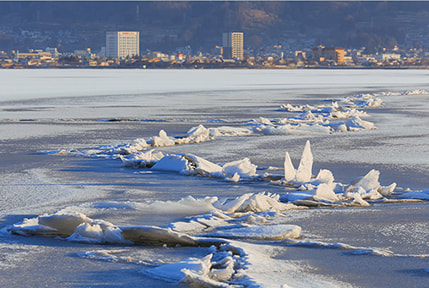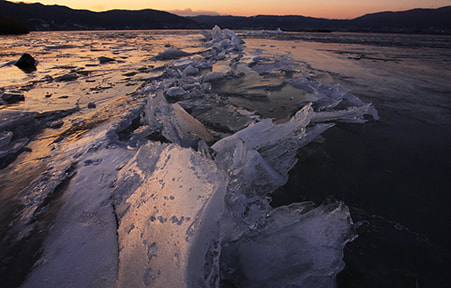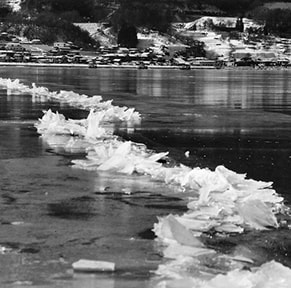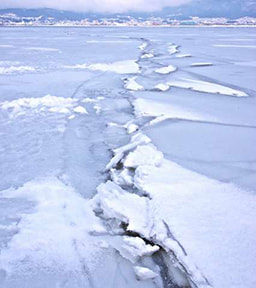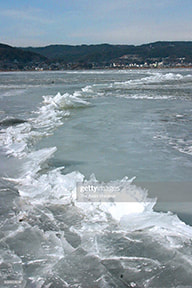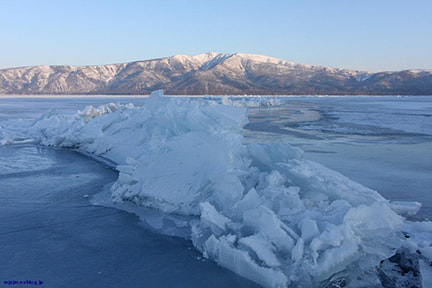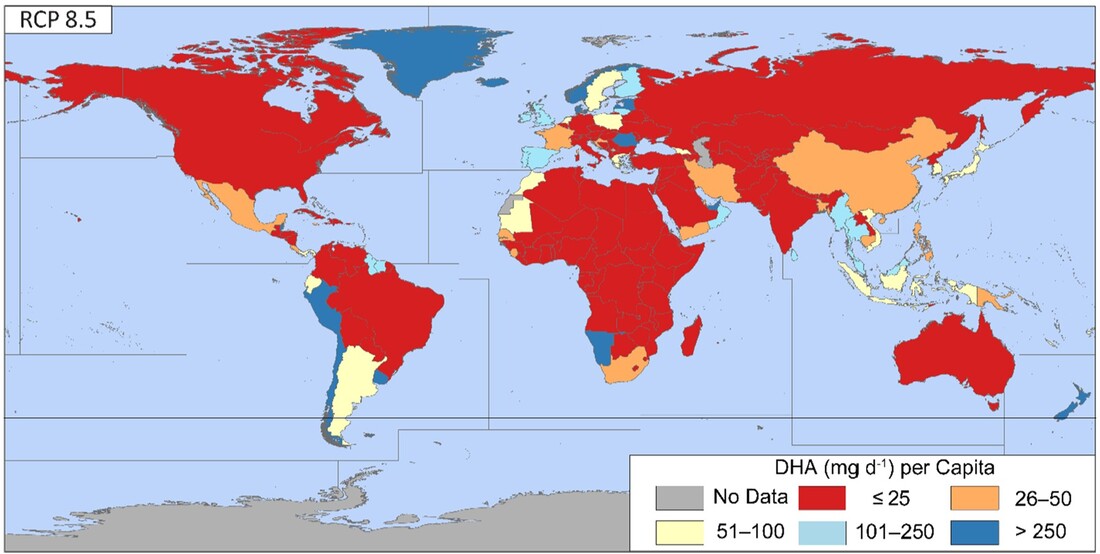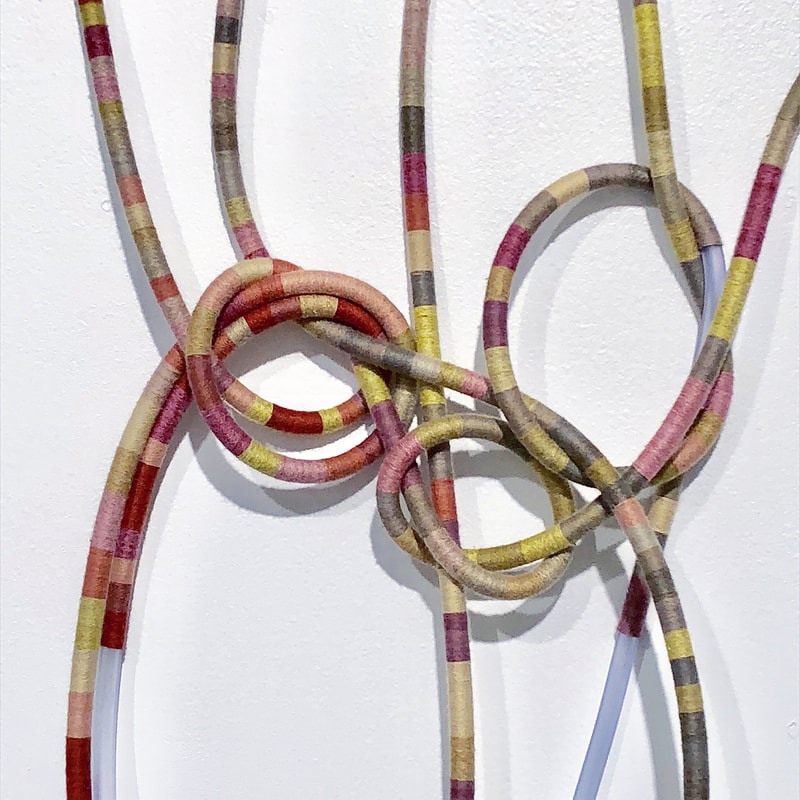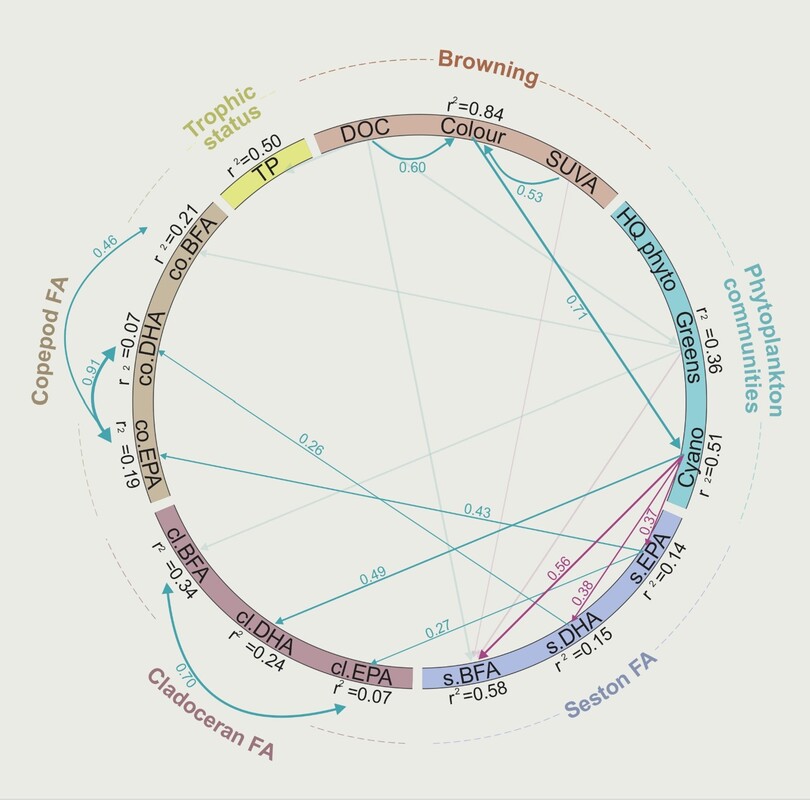|
Tali In Oscar’s last post he mentioned how Japanese monks had been recording lake freeze for 700 years - a tangible example of the production of knowledge as a time- and labor-intensive process that is contributed to generation after generation, each generation dependent on the last. And also an example of how scientific knowledge may have unexpected origins. While what our generation of scientists sees is a record of climate change, the monks were not intentionally leaving behind a record for this purpose. They were instead recording the date omiwatari (a ridge of ice) forms as the time of year that gods crossed the lake, leaving behind footprints - knowledge that is the result of a spiritual/communal relationship to place. I listen to a lot of books while working in the studio, and as I browsed through photos of omiwatari through google image search, I was reminded of one of my favorite passages from the chapter, “The Blue of Time” in Robert Macfarlane’s Underland. I am sharing that passage with you here: “Ice has a memory. It remembers in detail and it remembers for a million years or more. Ice remembers forest fires and rising seas. Ice remembers the chemical composition of the air around the start of the last Ice Age, 110,000 years ago. It remembers how many days of sunshine fell upon it in a summer 50,000 years ago. It remembers the temperature in the clouds at a moment of snowfall early in the Holocene. It remembers the explosions of Tambora in 1815, Laki in 1783, Mount St Helens in 1482 and Kuwae in 1453. It remembers the smelting boom of the Romans, and it remembers the lethal quantities of lead that were present in petrol in the decades after the Second World War. It remembers and it tells - tells us that we live on a fickle planet, capable of swift shifts and rapid reversals. Ice has a memory and the colour of this memory is blue. High on the ice cap, snow falls and settles in soft layers known as firn. As the firn forms, air is trapped between snowflakes, and so too are dust and other particles. More snow falls, settling upon the existing layers of firn, starting to seal the air within them. More snow falls, and still more. The weight of snow begins to build up above the original layer, compressing it, changing the structure of the snow. The intricate geometries of the flakes begin to collapse. Under pressure, snow starts to sinter into ice. As ice crystals form, the trapped air gets squeezed together into tiny bubbles. This burial is a form of preservation. Each of those air bubbles is a museum, a silver reliquary in which is kept a record of the atmosphere at the time the snow first fell. Initially, the bubbles form as spheres. As the ice moves deeper down, and the pressure builds on it, those bubbles are squeezed into long rods or flattened discs or cursive loops. The colour of deep ice is blue, a blue unlike any other in the world - the blue of time. The blue of time is glimpsed in the depths of crevasses. The blue of time is glimpsed at the calving faces of glaciers, where bergs of 100,000-year-old ice surge to the surface of fjords from far below the water level. The blue of time is so beautiful that it pulls body and mind towards it. Ice is a recording medium and a storage medium. It collects and keeps data for millennia. Unlike our hard disks and terrabyte blocks, which are quickly updated or become outdated, ice has been consistent in its technology over millions of years. Once you know how to read its archive, it is legible almost as far back - as far down - as the ice goes. Trapped air bubbles preserve details of atmospheric composition. The isotopic content of water molecules in the snow records temperature. Impurities in the snow - sulphuric acid, hydrogen peroxide - indicate past volcanic eruptions, pollution levels, biomass burning, or the extent of sea ice and its proximity. Hydrogen peroxide levels show how much sunlight fell upon the snow. To imagine ice as a “medium” in this sense might also be to imagine it as a “medium” in the supernatural sense: a presence permitting communication with the dead and the buried, across gulfs of deep time, through which one might hear distant messages from the Pleistocene. Ice has an exceptional memory - but it also suffers from memory loss. The weight on 2,000-year-old ice can reach half a ton per square inch. The air in this ice has been so compressed that cores brought up by deep drilling will fracture and snap as the air expands. This is why glaciers sound like shooting ranges. This is why if you were to drop a piece of very old blue ice in a glass of water or whisky, it might shatter the glass. Deeper still – in ice aged between 8,000 and 12,000 years - the pressure becomes so great that air bubbles can no longer survive as vacancies within the structure of the ice. They vanish as visible forms, instead combining with the ice to form an ice-air mixture called clathrate. Clathrate is harder to read as a medium, and the messages it holds are fainter, more encrypted. In mile-deep ice, individual layers can only just be made out as “greyish ghostly bands... visible in the focused beam of a fibre-optic lamp”. And because ice flows - because it continues to flow even when under immense pressures - it distorts its record, its layers folding and sliding, such that sequence can be almost impossible to discern. At the deepest points of the Greenland and Antarctic ice cap, where the ice is miles deep and hundreds of thousands of years old, the weight is so great that it depresses the rock beneath it into the Earth’s crust. At that depth, the compressed ice acts like a blanket, trapping the geothermal heat emanating from the bedrock. That deepest ice absorbs some of that heat, and melts slowly into water. This is why there are freshwater lakes sunk miles below the Antarctic ice cap - 500 or more of these subglacial reservoirs, showing up as spectral dashed outlines on maps of the region, unexposed for millions of years, as alien as the ice-covered oceans thought to exist on Saturn’s moon, Enceladus. As a human mind might, late in life, struggle to remember its earliest moments - buried as they are beneath an accumulation of subsequent memories - so the oldest memory of ice is harder to retrieve, and more vulnerable to loss.” Oscar In a recent study, a group of scientists explore the rates production of omega-3 fatty acids (essential for humans - and all animals -, produced by algae, and making their way to our diet through fish) under different climate scenarios. Their findings suggest that increasing water temperature will reduce omega-3 production, limiting their availability to meet human needs globally (especially in African inland regions), and putting human health at risk. This study represents one of the many consequences of climate change for human health. Sometimes, causal relationships (like those depicted in this study) are obvious or easily identifiable (i.e., consuming healthy food reduces risk of health loss); however, in many cases, causality is represented by complex causal pathways (higher temperatures → less omega-3 availability → Increased risk of health loss), or even causal networks (temperature-driven changes can also lead to higher toxin production, and as a consequence, fish kills, food poisoning, economic loss…) In our last conversation, Tali and I focused (partially) on causal networks, and how we explore and explain relationships. In Tali’s Inextricably bound project; one way in which complex relationships are represented is using different materials. Synthetic tubing used for medical purposes is combined with natural thread and dyes to represent reliance on petroleum and consequences for climate but also for human health (more here). In my work, statistical analyses reveal interactions between different characteristics of water (nutrients, color), algae, and crustaceans, and their implications for (also) omega-3 production and availability. While our approaches are different, our work intersects conceptually. We can bring the study of causal interactions a step further. When we have a question (or formulate a hypothesis) that is answered through exploration of a dataset to generate an outcome (artwork or articles), we are expecting to cause a reaction on the audience. This could spark further interest, raise awareness, promote further research, and/or favour feedback, expanding this knowledge network, which starts on our interest on the topic, and grows with greater exposure. In this context, SciArt and The Bridge program function as facilitators or triggers of these reactions, keeping the knowledge causal network growing. More to come; stay tuned…
0 Comments
Leave a Reply. |

